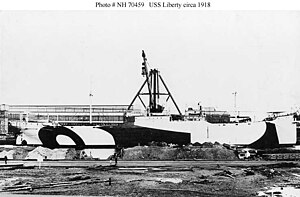World War II
By 1939, Liberty—although owned by the United States Maritime Commission (a successor to the USSB)—was employed by the Southgate-Nelson Corporation of Norfolk, Virginia. Southgate-Nelson was the operator of several packet lines, including the American Hampton Roads Line, the Yankee Line, and the Oriole Lines, but secondary sources do not indicate for which of these services Liberty sailed. [3] In November 1940, Liberty was one of ten ships taken up by the United States Army for defense service. [4] [Note 1]
At the time of the United States' entry into World War II in December 1941, USAT Liberty was in the Pacific. In January 1942, she was en route from Australia to the Philippines with a cargo of railway parts and rubber. On 11 January, Liberty was torpedoed by Japanese submarine I-66 about 10 nautical miles (19 km) southwest of the Lombok Strait, near position 08°54′S115°28′E / 8.900°S 115.467°E / -8.900; 115.467 . US destroyer Paul Jones and Dutch destroyer Van Ghent took the damaged ship in tow attempting to reach Celukan bawang harbour at Singaraja, the Dutch port and administrative centre for the Lesser Sunda Islands, on the north coast of Bali. However she was taking too much water and so was beached on the eastern shore of Bali at Tulamben so that the cargo and fittings could be salvaged.
In 1963 the tremors associated with the eruption of Mount Agung caused the vessel to slip off the beach, and she now lies on a sand slope in 25 to 100 feet (7.6 to 30.5 m) of water, providing one of the most popular dive sites off Bali.
The wreck of USAT Liberty is often misidentified as USAT Liberty Glo [Note 2] or identified by the misnomer, USS Liberty. The wreck is sometimes incorrectly referred to as a Liberty ship, through confusion of the ship's name with the class of World War II-built standard design cargo ships.
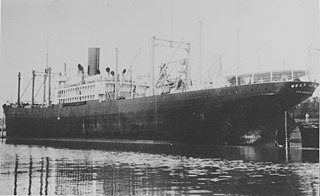
The USAT Meigs was a United States Army transport ship that was built in 1921 and sunk in Darwin Harbour in the first Japanese air raid against the Australia mainland on 19 February 1942.

Hog Islanders is the slang for ships built to Emergency Fleet Corporation designs number 1022 and 1024. These vessels were cargo and troop transport ships, respectively, built under government direction and subsidy to address a shortage of ships in the United States Merchant Marine during World War I. American International Shipbuilding, subsidized by the United States Shipping Board, built an emergency shipyard on Hog Island at the site of the present-day Philadelphia International Airport.

USAT Brigadier General M. G. Zalinski was a U.S. Army transport ship that served in World War II. It sank in 1946 in the Grenville Channel in British Columbia's Inside Passage. The crew were rescued by a tug boat and the SS Catala passenger steamer, but the cargo of bombs and oil went down with the ship.
Tulamben is a small fishing village on the north-east coast of Bali. It is among the most popular dive sites on Bali since the wreck of the Liberty, a US Army Transport ship torpedoed by a Japanese submarine in 1942 lies just off shore. During high-season, up to 100 divers descend to the wreck each day.
Several ships have been named Liberty:

USS Bali was a Dutch cargo steamship that was built for Stoomvaart Mattschappij Nederland in 1917. She served in the United States Navy, with the ID number ID–2483, from March 1918 until May 1919. She supplied the American Expeditionary Forces in France, and in 1919 she took food relief to Europe.
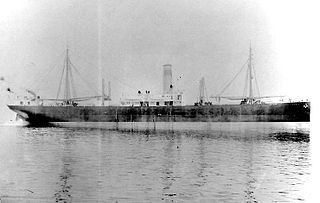
SS Ohioan was a cargo ship built in 1914 for the American-Hawaiian Steamship Company. During World War I, she was taken over by the United States Navy and commissioned as USS Ohioan (ID-3280).
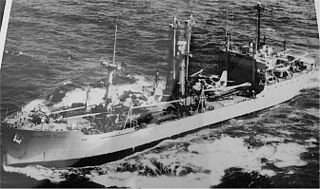
USNS Colonel William J. O’Brien (T-AK-246) was a US Maritime Administration (MARCOM) C1-M-AV1 type coastal cargo ship, originally planned as an Alamosa-class cargo ship. Constructed as Maiden's Eye for the MARCOM, completed in August 1945 and placed in operation by the War Shipping Administration (WSA). After the war Maiden's Eye was transferred to the US Army and renamed USAT Colonel William J. O’Brien who kept her in service until transferred to the US Navy in 1950 for operation as USNS Colonel William J. O’Brien (T-AK-246) by the Military Sea Transportation Service (MSTS) until 1973.
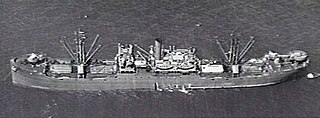
USS West Corum (ID-3982) was a cargo ship for the United States Navy in 1919. The ship was built as SS West Corum and reverted to that name at the end of her Navy service. During World War II, the ship was United States Army transport ship USAT West Corum, later renamed to Will H. Point.

SS Edenton was a steel-hulled cargo ship built in 1918 for the United States Shipping Board as part of the Board's World War I emergency shipbuilding program.

USS Berwyn (ID-3565) was a United States Navy cargo ship in commission from 1918 to 1919. She saw service in the final weeks of World War I, then entered commercial service in 1919 as SS Berwyn. She was wrecked in 1920.

The SS Clarksdale Victory was the 80th Victory ship built during World War II. She was launched by the California Shipbuilding Company on January 27, 1945, and completed on February 26, 1945. The ship’s United States Maritime Commission designation was VC2-S-AP3, hull number 80. She was built in just 86 days under the Emergency Shipbuilding program. SS Clarksdale Victory served in the Pacific Ocean during WW2. SS Clarksdale Victory was 80th of the new 10,500-ton class ship known as Victory ships. Victory ships were designed to replace the earlier Liberty Ships. Liberty ships were designed to be used just for WW2. Victory ships were designed to last longer and serve the US Navy after the war. The Victory ship differed from a Liberty ship in that they were: faster, longer and wider, taller, a thinner stack set farther toward the superstructure and had a long raised forecastle.

SS Hagerstown Victory was a Victory ship-based troop transport built for the U.S. Army Transportation Corps (USAT) late in World War II under the Emergency Shipbuilding program. It saw service in the European Theater of Operations during 1945 and in the immediate post-war period repatriating U.S. troops. Hagerstown Victory was one of 97 cargo Victory ships converted to a troopship.

SS Rushville Victory was a Victory ship-based troop transport built for the US Army Transportation Corps (USAT) late in World War II under the Emergency Shipbuilding program. It saw service in the European Theater of Operations in 1945, 1946 and in the immediate post-war period repatriating US troops.
The following index is provided as an overview of and topical guide to Wikipedia's articles on recreational dive sites. The level of coverage may vary:

Recreational dive sites are specific places that recreational scuba divers go to enjoy the underwater environment or for training purposes. They include technical diving sites beyond the range generally accepted for recreational diving. In this context all diving done for recreational purposes is included. Professional diving tends to be done where the job is, and with the exception of diver training and leading groups of recreational divers, does not generally occur at specific sites chosen for their easy access, pleasant conditions or interesting features.
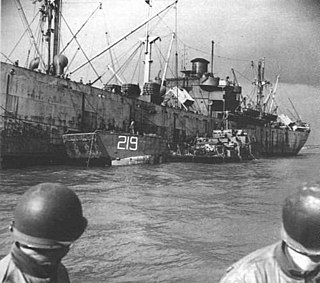
SS Alexander Majors was a Liberty ship built for the United States Maritime Commission during World War II. The ship was named in honor of Alexander Majors an American who with William Hepburn Russell and William B. Waddell founded the Pony Express. The ship was assigned by the War Shipping Administration to Isthmian Steamship Company of New York who operated it throughout World War 2. Alexander Majors was Laid down on 27 December 1943, launched on 20 January 1944 and completed on 4 March 1944, with the hull No. 2262 as part of the Emergency Shipbuilding Program.

SS Barbara Olson was a cargo ship built in Wisconsin in 1918 as the SS Corrales. Barbara Olson was able to escape an attack off the coast of California in the early days of World War II. The Barbara Olson was built under a United States Shipping Board (USSB) contract in 1918 as the SS Corrales and renamed in 1940. On July 25, 1942, she was chartered by the US Army to transport supplies to the Territory of Hawaii as the USAT Barbara Olson for World War II. On January 14, 1946, her Army service ended. In 1964 she was run aground four miles (6.4 km) north of Pimentel, Peru and declared a total loss.
This page is based on this
Wikipedia article Text is available under the
CC BY-SA 4.0 license; additional terms may apply.
Images, videos and audio are available under their respective licenses.
